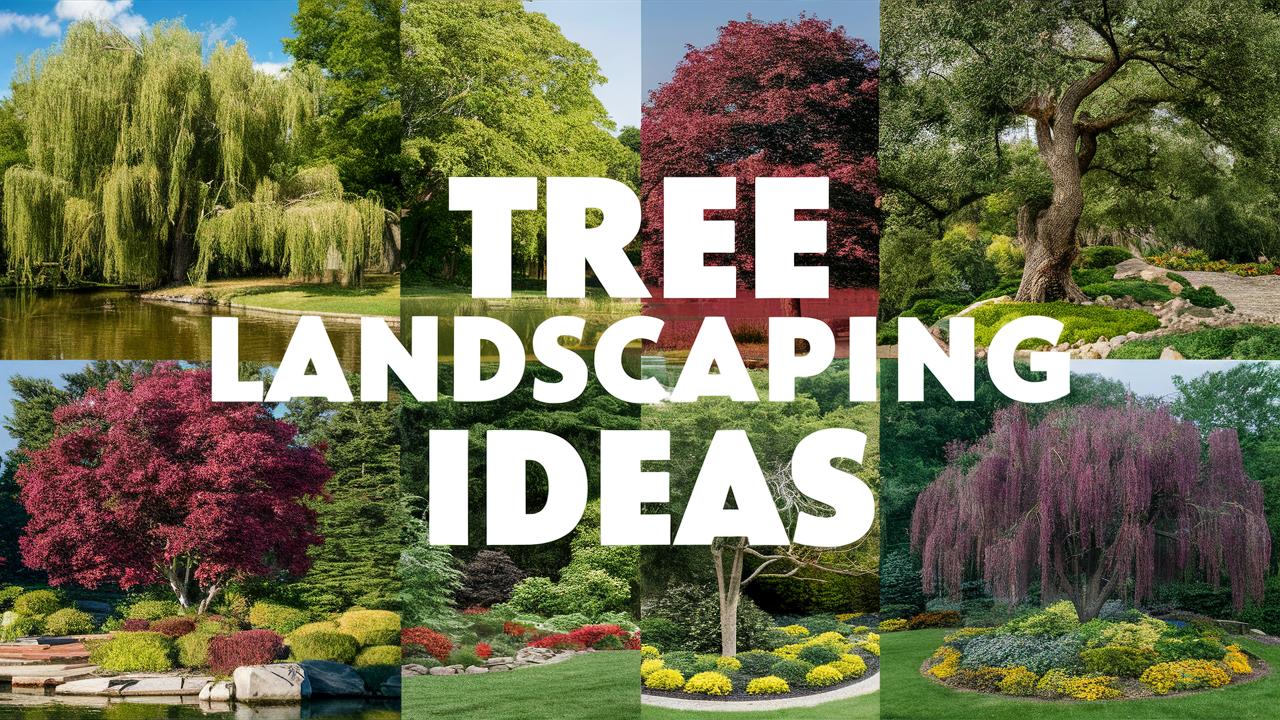In this guide, we will explore a plethora of tree landscaping ideas that can help you create a stunning garden or yard tailored to your unique tastes and environment.
View this post on Instagram
I’m really digging how this design uses different colors and textures. The low rock wall and pebble border is a clever way to define the space, but still keeps it natural and organic. And that pop of red foliage? Genius! Imagine something like this around the base of your trees… it would really make them stand out, right? I particularly love how the bromeliads add a splash of the tropics to the whole thing.
View this post on Instagram
Hey, how about this for some inspiration? I love how the dappled sunlight hits those harlequin willows with their variegated leaves! The combination of bright, colorful flowers against the backdrop of that cool-toned fence is just amazing. The mix of textures, from the shrubs to the perennials, really brings the whole thing together too! It’s definitely got me thinking about incorporating something similar into my own yard!
View this post on Instagram
Sometimes simplicity is key, right? How about a design that’s all about texture and shape? I love how the rounded shrubs and those cute little trees create such a cozy, welcoming feel. Plus, the pops of color from the foliage plants add interest without being too overwhelming. It’s like a hug for your eyes every time you pull into the driveway. You could scale this to any size of yard.
View this post on Instagram
I am just loving the tropical vibes of this one! The way the different layers of greenery play off each other is just so lush and relaxing. It creates a total sense of privacy too with that dark fence in the back, the medium layer of banana trees and the shorter layer of philodendron really brings this to the max. You could easily adapt this to any fence size and still feel you are getting the same lush feel. I could totally see myself relaxing out there with a good book.
View this post on Instagram
This design is super classic and gives a polished vibe, right? I love the repetition of the round trees, how they add height and draw your eye along the front of the house, while the lower bushes create a neat, defined border. It has a very structured look, which really complements the architecture of the house. Plus, the little trees in those square planters are just adorable. Overall, it’s a sophisticated look that’s also inviting and feels manageable.
View this post on Instagram
This design really caught my eye because it’s different. Imagine a statement tree, like a grass tree, in a rusted metal pot, providing a unique contrast with surrounding greenery. Low grasses and trailing plants around the base create a really natural look, almost softening the edges of the pot. Then, you add some strategically placed lighting to highlight the textures and give it that extra “wow” factor, especially at night. It’s like bringing a bit of the desert right to your front yard, but with a modern twist!
View this post on Instagram
If you are into a bit of formal structure, how about using trees and shrubs to define a space? I love how this design uses tall, columnar trees to create privacy and a sense of enclosure around the patio. The manicured boxwoods add a touch of sophistication, and the open lawn beyond feels like a secret garden. Plus, imagine the dappled sunlight filtering through the trees in the late afternoon – so dreamy. The stone patio also provides a great location for eating or entertaining.
View this post on Instagram
Here’s an idea to create a really neat border. Imagine using those dense evergreens as a natural fence, giving you some privacy and a backdrop for colorful flowers. A flower bed in front with mixed colors really pops, doesn’t it? And those little lights tucked in make it all glow at night – pretty cool and elegant. It’s a fairly simple design, but it feels so lush and well-maintained, right?
View this post on Instagram
I’m kind of obsessed with this tree-lined landscaping idea, its just so clean. Imagine a row of these trees to create a lush green privacy screen, especially if you’re dealing with close neighbors. Underneath, the hydrangeas add a beautiful touch of white, softening the bold lines of the fence. It feels really structured but still has a natural, relaxed vibe. I think it’s great inspiration for anyone looking to add some elegance and privacy to their outdoor space.
View this post on Instagram
I’m kind of in love with this design! The way the deck just flows around the tree, creating its own little green island, is so clever. And that pizza oven in the background? Talk about outdoor entertaining goals! Plus, the bamboo screen adds a nice touch of privacy. The different levels of the deck are pretty great too, offering some visual interest to the yard.
View this post on Instagram
I’m really feeling how natural this design looks, you know? The tree looks like it’s happily part of the house and not fighting it, and the big stones just hanging out feel organic and intentional. Plus, the plants aren’t competing; they’re just a nice mix of textures and colors. I like how the taller, thinner evergreens punctuate the space and give it height. It’s elegant, but it’s not overdone, and the mulch ties everything together seamlessly.
View this post on Instagram
Here’s a clean, symmetrical look! I love how the repeating trees draw your eye along the house, and those stone rings make such a tidy border. Plus, adding a bit of mulch inside is a nice touch to keep things looking polished. It’s a great way to add structure without feeling too formal, don’t you think? This kind of design could work really well if you’re after something both classic and modern.
View this post on Instagram
I’m really digging this almost prehistoric vibe! It’s got these cool, palm-like trees that bring some serious height and drama, totally juxtaposed with the round Golden Barrell cactus in the foreground. I like how the smooth trunks and softer textures balance out the cacti’s spikiness, and adding some ground cover succulents adds a nice touch of green carpet. It feels like a little desert oasis, don’t you think? It might be a fun idea if your up for some unique landscaping and its pretty low maintenance too.
View this post on Instagram
Okay, what do you think of this for a grand entrance? I love the way these palms immediately give a sense of arrival and warmth and they don’t crowd the house. The clean, modern walkway really makes the palms pop, too. Then the perfectly manicured hedges along the walkway create a nice bit of formality to the design as well. It is a great blend of the tropics with a modern, well curated look.
Tree Landscaping Ideas: Transforming Your Outdoor Space with the Power of Trees
When it comes to landscaping, few elements can make as significant an impact as trees. Their stature, beauty, and ability to transform any outdoor space cannot be understated. Trees offer shade, privacy, and ecological benefits, while also adding aesthetic appeal.
The Importance of Trees in Landscaping
Before we dive into specific ideas, let’s take a moment to appreciate why trees are so essential in landscaping. Trees provide numerous benefits, including:
Environmental Advantages: Trees improve air quality, provide oxygen, and support biodiversity by serving as habitats for various wildlife species. They also help in soil erosion control and maintaining water cycles.
Aesthetic Enhancement: With their diverse shapes, colors, and sizes, trees contribute significantly to the visual interest of any landscape. They can serve as focal points, provide a sense of balance, and offer seasonal excitement with changing foliage.
Shade and Cooling Effects: Strategically placed trees can help reduce energy costs by providing shade to homes and outdoor spaces. They naturally cool the environment, making your outdoor areas more enjoyable during hot weather.
Privacy and Sound Barriers: Tall trees can act as natural privacy screens by blocking undesirable views and absorbing sound, allowing you to enjoy your garden in peace.
Now that we understand the importance of trees in landscaping, let’s delve into some creative tree landscaping ideas to elevate your outdoor space!
Create a Canopy Walkway
Imagine strolling through your garden under a canopy of trees—the dappled sunlight filtering through the leaves creates an ethereal atmosphere. To achieve this, consider planting trees with expansive, overlapping canopies such as maples or oaks along a designated pathway.
Enhancing this walkway with low-growing plants and flowers can also add layers of visual appeal while maintaining a natural look. Use mulch or gravel for the path to introduce texture to the landscape. As the trees grow, they will form a shaded tunnel that invites exploration, making it an ideal setting for quiet reflection or family gatherings.
Use Ornamental Trees as Focal Points
Ornamental trees serve as stunning focal points in any landscape design. Varieties like the Japanese Cherry Blossom, Dogwood, or Magnolia not only display beautiful blooms but also have unique shapes that draw the eye.
Consider planting an ornamental tree at the end of a long vista or at a prominent corner of your yard. Surround it with perennial flowers or a bed of seasonal blooms to complement its beauty and expand the visual narrative of your garden. The layering of trees and flowers provides dynamic contrast and can cater to different bloom times, ensuring that there’s always something beautiful to look at.
Form an Outdoor Room
Trees can also be utilized to create enclosed spaces, resembling an outdoor room. Planting trees in a strategic manner allows for the formation of boundaries that provide privacy without the need for solid fencing.
Choose faster-growing varieties like willows or poplars to create your tree room quickly. Create a cozy seating area within this enclosed space, furnished with comfortable chairs, a fire pit, or a hammock. Incorporate string lights for a magical evening ambiance and enjoy the beauty of nature while entertaining friends and family.
Layer Trees for Depth and Texture
One effective landscaping strategy involves layering trees of varying heights and textures to create depth and interest. By mixing tall trees, medium-sized specimens, and understory trees, you can develop a dense, multi-dimensional garden.
For example, plant a towering pine or oak at the back of your garden, with mid-size flowering trees like the Redbud in front, and smaller shrubs or evergreens framing the sides. This intentional layering gives the impression of a lush forest, encouraging wildlife to visit while providing a habitat for birds and beneficial insects.
Install a Tree House
If you have children or grandchildren, consider installing a tree house for endless hours of fun and imagination. Trees like sturdy oaks or elms can provide the perfect foundation for a tree house that blends seamlessly with the landscape.
Design your tree house with safety in mind, ensuring it has secure ladder access, a solid railing, and ample room for play. Decorate the surrounding area with swings, a sandbox, or a garden, making your tree house the centerpiece of a whimsical outdoor adventure zone.
Craft a Wildlife Habitat
Integrating trees that attract wildlife can turn your landscape into a sanctuary. Plant native species such as serviceberry or elderberry, which draw birds and pollinators, while also providing food sources and shelter.
Incorporate features like birdhouses, butterfly gardens, and bee hotels to enhance the habitat further. By creating a diverse ecosystem with different tree types, shrubs, and wildflowers, you will encourage bees, butterflies, and birds to make their home in your yard, turning it into a dynamic and lively place.
Embrace Vertical Gardening with Trees
If you’re dealing with a smaller yard or want to optimize your space, consider incorporating vertical gardening with trees. The idea is to utilize trees as living trellises or screens while also adding climbing plants or vines such as clematis or wisteria.
By allowing these fast-growing vines to climb up your vertical trees, you not only gain visual interest but also create privacy and shade. This technique is excellent for creating intimate outdoor spaces in tight urban environments while maintaining a green atmosphere.
Use Trees for Seasonal Displays
To keep your landscape vibrant throughout the year, focus on seasonal displays using trees. Selecting varieties that showcase colorful foliage in the fall, blooming flowers in the spring, and interesting bark structures in winter can enliven your outdoor space all year long.
For instance, plant a sugar maple for its stunning fall colors, followed by a flowering crabapple for early spring blooms. In winter, trees such as the river birch with its peeling bark add visual intrigue. Plan your landscape with seasonal continuity in mind to ensure that your yard remains a feast for the eyes year-round.
Design An Edible Landscape
Trees can be an integral part of an edible landscape, offering delicious fruits while beautifying your garden. Consider planting varieties like apple, peach, or cherry trees that will grow well in your climate and soil conditions.
Incorporate these fruit-bearing trees into your overall design by placing them where they can be easily accessed for picking. Surround your trees with complementary vegetables and herbs to create an edible garden where aesthetics and functionality collide. This unique approach not only provides a wonderful harvest but also encourages you to connect more deeply with your landscape.
Create a Sensory Garden
A sensory garden aims to engage all five senses through plant selections and arrangements. Trees can play a significant role in this design by offering textures, sounds, and scents.
Choose trees like the fragrant Southern Magnolia or the aromatic Cedar for their delightful smells. Incorporate fountains nearby to introduce the calming sound of water, and plant flowering species that attract pollinators. A sensory garden can become a therapeutic space where you can immerse yourself in the beauty and diversity of nature.
Plan for Mature Growth
When selecting trees for landscaping, it’s vital to consider their mature size and growth habits. A tree that is too large for a small garden can lead to overcrowding and maintenance issues. Research the potential of each species you want to plant to ensure it fits harmoniously into your space.
For small gardens or patios, opt for dwarf or small-sized varieties, such as Japanese maples or flowering dogwoods. Understanding the potential growth of trees will allow you to minimize the need for heavy pruning while maximizing their beauty in your landscape.
Consider Hardscaping with Trees
Integrating trees into your hardscaping projects can create a more cohesive outdoor design. Consider placing large trees strategically alongside patios, walkways, and retaining walls to add contrast and soften the hard edges of these structures.
Additionally, creating tree groves within paved spaces or building wooden decks around existing trees can add elegance to modern landscapes while preserving natural beauty. This thoughtful approach will enhance the overall architectural appeal of your outdoor environment.
Incorporate Trees into Existing Structures
If you already have elements like decks, patios, or pergolas, consider incorporating trees into these existing structures. A tree growing through a deck or a patio that incorporates an existing tree can create a stunning visual dynamic that showcases nature within your outdoor living area.
Using containers or raised beds can also allow you to introduce smaller trees or shrubs even if your soil conditions are not ideal. This technique adds uniqueness to your landscaping while enriching your outdoor space with the beauty of trees.
Create an Allée of Trees
An allée, or tree-lined avenue, can be a spectacular addition to your landscaping. This formal arrangement, where trees are planted in a row along a pathway or driveway, exudes sophistication and invites guests to experience the grandeur of your property.
Consider using a uniform species, like Lombardy poplars or sycamores, to maintain cohesion. Planting flowering varieties will create stunning seasonal displays, impressively welcoming visitors to your home.
Celebrate the Native Tree Canopy
One of the most eco-friendly landscaping ideas is to celebrate and integrate native tree species into your design. Native trees not only adjust better to local climates but also require less maintenance and provide habitat for local wildlife.
Conduct research on local varieties suited for your area and design your landscape to reflect the natural beauty of your environment. Incorporating native trees fosters a connection to local ecosystems and promotes biodiversity, creating a healthier landscape for you and future generations.
Conclusion
Trees are nature’s architectural marvels that offer a wealth of benefits, aesthetics, and environmental advantages. By incorporating thoughtful landscaping ideas, you can create a lush and inviting outdoor space that reflects your personality while enhancing your surroundings.





